INTRODUCTION
Much of the culture of Norway can be traced back to the Vikings, a group of Scandinavian seafaring pirates, traders, and pioneers that settled in Northern Europe in the eighth century.
However, throughout their history, the people of this country have always identified with rural culture, which can be seen in its traditional costumes and folk music that are still celebrated today. More modern expressions of Norwegian culture include Jante Law and Constitution Day.
Jante Law is an essential part of modern Norwegian culture and emphasizes humility, equality, respect, and simplicity. In Jante Law, wealth is not flaunted, people don’t criticize others, and egalitarianism is key.
May 17 is Constitution Day, Norway’s holiday celebrating its nationhood. On this day, Norwegians participate in parades with bands, unions, civic and volunteer groups, schools, and performers.
FOOD AND CUISINE

Norway’s food culture is heavy on seafood, but the most typical food is thinly sliced brown cheese eaten with bread. Other popular cornerstones are cured or smoked salmon, whale steak, and Fiskepudding.
Breakfast usually includes fish, crispbread or flatbread, yogurt, cheese, coffee, and milk. Lunch includes fruit, coffee, and the popular open-faced sandwich with cheese, cold meat, or paté. Dinner consists of root vegetables such as carrots or boiled potatoes paired with fish and meats such as whale, chicken, beef, pork, or chicken.
On Constitution Day, Norwegians celebrate by eating flatbread, thinly sliced dried meats, porridge, beer, and aquavit.
FOLK MUSIC & DANCE
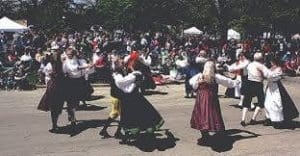
Norway folk music, also influenced by the Vikings, has an unbroken tradition in that it has been passed down to each generation for hundreds of years. The folk music culture consists of music in vocal and instrumental pieces that are often performed by soloists. Popular folk musicians and singers include Susanne Lundeng and Odd Nordstoga.
The traditional instrument for instrumental folk music in Norway is the Hardanger fiddle (hardingfele) followed by the harp. The Hardanger fiddle is often called the national instrument of Norway, and you can even hear it being used extensively in The Lord of the Rings soundtracks.
Typical traditional dances for Norway folk music include the Halling (hallingdansen), shown in Alexander Rybak’s winning performance at the Eurovision Song Contest.
The Norwegian Bunad
 A bunad is a traditional folk costume that you find all over Norway. Although much more popular with women, men’s bunads are also available.
A bunad is a traditional folk costume that you find all over Norway. Although much more popular with women, men’s bunads are also available.
The best time to see the outfit is on Norway’s national day, when the streets are full of bunad-wearing Norwegians of all generations! You may also people wearing one at weddings and other celebrations.
A modern tradition
The smart, colorful outfits are made with wool, meant to be tight-fitting, and are adorned with metal buckles, buttons and jewelry. Accessories vary and can even include blades.
Although believed by many tourists to be a tradition dating back hundreds of years, that’s not exactly true. Far from it in fact, as you can see from archive photographs from more than one hundred years ago.
The design of the modern bunad does take plenty of cues from traditional folk costumes dating back a few hundred years. However the modern dress we’re talking about in this article is very much a 20th-century invention.
While we’re on that subject, let’s take a look at how the costume came to be. For that, there’s one Norwegian woman to thank.
The mother of the bunad
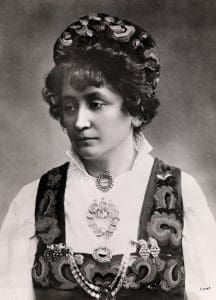
The person most often credited with the outfit’s ‘invention’ – or at least rekindling interest in traditional folk costumes – is Hulda Garborg.
The writer, novelist, playwright, poet and dancer spent many years travelling the country participating in debates and promoting Norwegian culture. This was a tough job, as it was during the time when many families were leaving Norway in search of a better life in America or elsewhere.
During the early-to-mid 1900s, Klara Semb took over the campaign and put the focus on developing “historically correct” bunads. Aagot Noss started to develop a written account of the traditions that modern bunads were based on in the 1950s.
When do Norwegians wear bunads?
Despite the wishes of some camera-wielding tourists, wearing a bunad is not something Norwegians do every day. Day-to-day, simple, practical clothing that suits the Norwegian climate is worn for work and regular social ocassions.
Since a bunad is a festival garment, less ornate traditional dress is more suitable and practical for work situations. Everyday cotton or wool costumes, colored and patterned shirts and aprons, and simpler silver accessories are among the possibilities.
However, the bunad does play an important role in a Norwegian’s major life events and special occasions.
Norwegians use it for various celebrations including weddings and possibly important birthdays and folk dances. It’s also often worn on religious occasions such as baptisms, confirmations, and sometimes at Christmas.
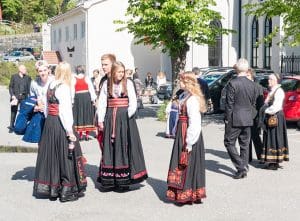 But without doubt the best day to admire the bunad out in public in Norway is on the 17th of May for the country’s Constitution Day celebrations, when almost everyone dons the national dress.
But without doubt the best day to admire the bunad out in public in Norway is on the 17th of May for the country’s Constitution Day celebrations, when almost everyone dons the national dress.
Consider getting an everyday (hverdags) dress, which is less expensive and easier to make and care for. If fabrics are carefully chosen and workmanship is excellent, you will have appropriate clothing for traditional events.
The rules of the bunad
Designs vary massively between regions. One primary function of a person’s bunad is to serve as a public appreciation of and homage to your Norwegian heritage in general and to your town or region of Norway in particular.
It is customary to wear a bunad or folkedrakt from an area to which you have a genetic or residential connection. Then you won’t have to explain to those who greet you (feeling they’ve found someone from their region) that you just liked that particular colour!
Your bunad should always display excellent quality fabric and workmanship. It should fit nicely, and be clean and in good repair. Staying in shape to fit in a bunad after many years can be quite the challenge!
Because you are wearing traditional (or traditionally related) clothing, conservative makeup and hairstyles are suitable.
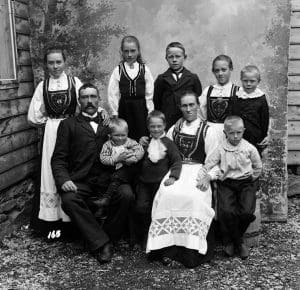
More contemporary additions such as earrings, high heels and nylons are out of place. References to the bunad police are made partly in jest!
Popular regional variants
One of the lesser known facts about the traditional dress is that there are a few hundred local varieties, with some saying there are up to 400.
That’s quite a selection for a country of little more than five million people! Here are some of the most notable versions:
Nordland
One of the most popular regional variants is the Nordlandsbunad, from the county of Nordland. The men’s version dating back to 1924 features dark blue stockings and a floral brocade vest over a stand-up collar shirt.
The female version is a rich blue dress with embroidered floral patterns on the skirt and top. Accessories include a shawl, apron, bag and a hat, all in blue of course. The Nordland outfit has regularly won the title “Norway’s most beautiful bunad” from the Norwegian media.
Hardanger
Known as “the first bunad”, Hardanger’s collection of designs vary in detail but are best known for their distinctive red body and white apron.
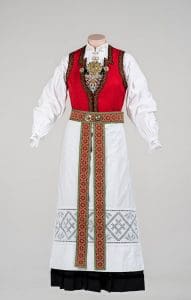
It is common to add a belt to the outfit at confirmation. According to tradition, the headgear worn depends on marital status.
Telemark
With a rich history in textile production and craftsmanship, Telemark in southern Norway is regarded by some as having the “Norwegianest” bunads.
Based on costumes from the 19th-century, Telemark’s bunads differ between the west and the east, but at first glance appear similar: both feature a predominantly deep shade of blue, the same cut, and red/green embroidery.
Hallingdal (Buskerud)
The distinctive elements of the Hallingdal bunads include the contrast between the dark fabric and the vivid colours used in the embroidery.
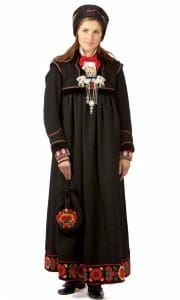
This bunad is designed without a belt, although one can be added if desired. Embroided headgear is also a common accessory.
Trøndelag
While different variations do exist within the vast region, the Trøndelag bunad was created in 1923 in an attempt to create a common bunad for the entire region of central Norway.
Inspired by Roccoco fashion from the 18th-century, it is one of the easiest to spot even though it can come in green, red or blue varieties, the latter being the most common.
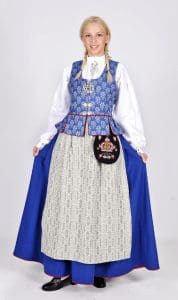
Bunad jewellery & accessories
Silver was (and still is, in some parts!) a very important material in Norway, steeped in superstition and legend. According to one legend, the silver mines belonged to the mountain trolls as they were such good silversmiths.
For many years silver was used by locals to protect themselves against bad weather and storms, to heal illness, and even to consecrate water. According to some stories, a silver brooch would often be pinned on the clothing of a baby so trolls couldn’t swap the infant with one of their own!
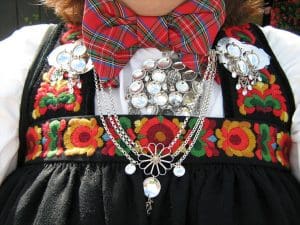
Because of this spiritual connection and ancestral value, pieces of silver were often handed down for generations within families.
As with the bunad itself, the design of the associated jewellery varies in design regionally. Some of the silver jewellery often found on a woman’s bunad includes:
- Neck pin/button to hold the shirt together at the neck
- Brooch fastened across the front of the shirt rather than the bunad
- Accessories including cufflinks, shoe buckles, rings, and belts
Typically, less is more when it comes to accessorising the national costume.
Hardanger Embroidery (Norway)
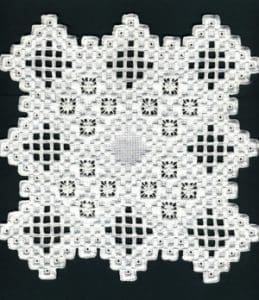
Example of modern Hardanger embroidery
Hardanger embroidery (Hardanger work) is a general term for various forms of counted thread and whitework that were originally produced in Norway. Hardanger work derives from the Hardanger district in the western part of the country. Traditional Hardanger work is characterised by the use of a white, even-weave cloth (sometimes with double warp and weft threads) with a fairly thick, white cotton or linen embroidery thread.
The designs are built up using blocks of geometric designs worked in satin stitch or straight stitch (sometimes called kloster blocks) and small open squares that are formed when both warp and weft threads are removed in a particular area (as in cutwork) or pulling either warp or weft threads (as in drawn thread work). This type of embroidery is used to decorate garments and household furnishings, such as doilies, table cloths, towels, etc.
Hardanger whitework is also a feature on the hem area of aprons associated with traditional women’s costumes from this part of Norway. Hardanger embroidery became popular in various other countries from the late nineteenth century until the present day. In addition, coloured threads have also started to be used.
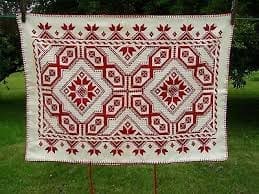
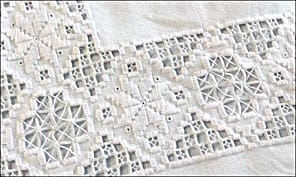
TOURISM
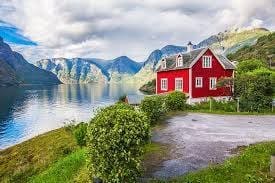
Norway is a Scandinavian country encompassing mountains, glaciers and deep coastal fjords. Oslo, the capital, is a city of green spaces and museums. Preserved 9th-century Viking ships are displayed at Oslo’s Viking Ship Museum. Bergen, with colorful wooden houses, is the starting point for cruises to the dramatic Sognefjord. Norway is also known for fishing, hiking and skiing, notably at Lillehammer’s Olympic resort.
Official tourism website: https://www.visitnorway.com/
ARTICLE CURATED BY : BHAVIKA GULRAJANI
IMAGE COURTESY:GOOGLE

